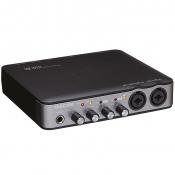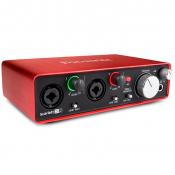Product Comparison: Tascam US-200 vs Focusrite Scarlett 2i2 (2nd Gen)
This site is a free online resource that strives to offer helpful content and comparison features to its visitors. Please be advised that the operator of this site accepts advertising compensation from certain companies that appear on the site, and such compensation impacts the location and order in which the companies (and/or their products) are presented, and in some cases may also impact the scoring that is assigned to them. The scoring that appears on this site is determined by the site operator in its sole discretion, and should NOT be relied upon for accuracy purposes. In fact, Company/product listings on this page DO NOT imply endorsement by the site operator. Except as expressly set forth in our Terms of Use, all representations and warranties regarding the information presented on this page are disclaimed. The information which appears on this site is subject to change at any time. More info


- I needed an audio/MIDI interface for an upcoming mobile recording session that was up-to-date with Mac OS X El Capitan and the US-200 came to the rescue.
- Very smooth sounding preamps, all the necessary connections and controls in a compact yet well built, reasonably priced unit. I'm very satisfied.
- I'd originally bought the 2x2 not realizing I'd be buying more analog equipment. So it was a no-brainer... i'm about to get the 20x20 and will have happy little family, hopefully.
- First recordings that I did were at a sampling rate of 96 kHz and there was very little buzzing that I could hear, but there was still a little buzzing.
- I like the fact that this unit has balanced inputs that can be used with either XLR or 1/4 in plugs.
- Lives up to it's specs: mediocre amps, mediocre conversion rate. It's a little noisy. Ok, given the price point.I would recommend spending a little more if you plan to mic a guitar or do real vocals.
- Horrible preamps. Condenser mics sound tinny. Dynamic mics are noisy at any reasonable level.
- Really low latency. Great sound quality at an affordable price.
- Pretty much what I wanted. Fairly clean, neutral and interference free sound using the balanced trs outputs to my JBL LSR305's.
- Pre-amps are of good quality, to be expected from Focusrite.
- Direct monitor ability is pretty useful for recording certain acoustic instruments that may not be very loud in the DAW.
- No Phono out. No Midi In.
- It colours the sound of the guitar. the bass is so deep you can't remove it from the software. it sounds like everything is covered by a blanket. I have the brightest sounding guitar on the market, all maple, and sounds like it's made of sponge








- The unit is solid and well built, looks really nice on the desktop, and sounds good.
- I like the look & the weight. It took me a minute to figure out that I needed to download a special thing to get the MIDI to work.
- I bought this because I needed a compact USB box to use on my laptop. I
- Very poor construction and components.
- Solid build, looks really good, compact and lightweight.
- Feels really well made and sturdy, the small form factor is great.
- The device is very ergonomically designed, one of the best on the market in that regard.
- The 2i2 has a superior build quality with a sleek solid metal case, the unit has a satisfying weight.
- Really professional interface. Unexpectedly for this price! Midi is accurate. USB interface - don't need to buy a thunderbolt dock.
- I have no real complaints. Midi in/out is seamless as well and knobs feel well constructed, they are heavy and not finicky.
- I bought this because I really liked the look and layout of the interface and I trust the good quality preamps. I was not disappointed in that.
- Excellent, low-latency interface that includes its own ASIO driver.
- Latency is the biggest problem in both the MIDI and analog inputs: and let's just admit right away that that's usually a combination of hardware and software.
- Only flaw is it doesn't come with the ports to connect your studio monitors through xlr, only RCA, which i just bought rca to xlr cables and that fixed it!
- The inputs on the front take both XLR cables and 6.3mm cables (For guitar jacks etc..). It looks great and easy to use.
- Just bear in mind line level input is by using 1/4inch jack not xlr. it is very easy.
- The headphones seem ideally suited to this interface and for general reference will probably replace my Shures as my work-a-day 'phones.
- It would be nice to have some analogue inputs on the back but can live without.
- The XLR cable included with the equipment is very low quality my headphones and cable have already started to mess up after 3weeks of use.
- It works great. i do not use the bundled software (I am on OSX 10.12) but instead use the drivers only (I had no issues here even before upgrading from 10.11) and an application called Loopback Audio.
- It sounds awesome. Absolutely a clean recording with no noise or artifacts.
- There is a bug with it where every time you startup your computer you have to unplug and plug the USB back into your computer in order for it to recognize it again.
- In Windows 10 the drivers are constantly dropping out and causing me headaches. It only allows for audio to be playing from one source at a time, so you can't listen to anything else if you have your recording software active.
- The settings panel looks like it was created by an amateur software designer.
- Handy indicator LED's to know if your signal is peaking or not.
- Headphones are great, the interface includes phantom power for condenser mics and the mic itself produces great audio.
- Each input lights up green or red if you overload it allowing one to quickly set the recording level.
- The "Gain Ring" is a really intuitive display for telling whether your input level is peaking or not.
- USB-C would be nice for the newer MacBook's however for much more money a USB-C model is available.
- Installing and registering the software proved to be a labyrinth of pointlessly difficult bull****.
Popular Comparisons






























